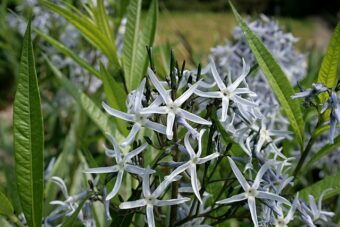In this article, we will discuss how to grow the unusual and rare Amsonia in containers. Amsonia are flowering plants that belong to the Dogbane family and is primarily native to North America. It is named after the American physician, John Amson and has the common name of Bluestar due to the star-like blue flowers that are produced on tall stems in early summer.

In early spring, willow-like foliage starts to emerge from slow-growing leafy clumps. From these leafy clumps in early summer, spikes of star-shaped blue flowers appear that cover the plant. As the flower fades, the leaves in early autumn turn a golden yellow giving an additional talking point.
Find out how to grow this interesting perennial of Amsonia in containers in this article.
GROWING AMSONIA IN CONTAINERS
You can grow Amsonia from seed but this is not recommended as germination is unpredictable and it can be slow as it can take up to 20 weeks to be able to plant in the garden.
If you want to go down this route, you can start in late winter to plant out in summer. First, fill a seed tray with seed compost and water well until the compost is moist, Sprinkle the Amsonia seeds on the compost and then gently press them down. Do not cover with more sieved compost as they need light to germinate and place a propagator lid on top to create a humid environment.
Place the tray in a cool room where temperatures are between 13 and 15 degrees Celsius. After 3 weeks, you will need to place your seed tray in a refrigerator and leave then there for three to six weeks. This will mimic a winter season for the seeds. Keep watering to ensure the compost is moist at all times but never soggy,
After being in the fridge for six weeks, you will need to move the container back to the cool room or greenhouse and soon after the seedlings should emerge. Not easy as you can imagine.

Once the seedlings are big enough, you can prick them out and transplant them into 7.5cm tall pots full of multipurpose compost.
You will then need to harden them off for two weeks before planting in containers sometime in summer.
SHOP-BOUGHT PLANTS AND SEED GROWN CAN BE TREATED THE SAME WAY
At this stage, shop-bought plants and home-reared plants can be treated in exactly the same way. First, choose a container that is well proportioned with the plant in question and will stick out when blue flowers are in them. Whatever you choose make sure it has plenty of drainage holes. Add a 1cm layer of gravel on top to aid drainage and on top of this, add multipurpose compost to 5cm below the top rim.
You can add a couple of handfuls of well-rotted manure to help enrich the compost.
Dig a hole in the compost that is slightly bigger than the root ball it came in the original container. Place the plant in the hole so that the top of the root ball is at the same level as the top surface of the compost. Backfill with the growing media ensuring that no gaps remain, using more compost if necessary. Firm the plant in and water well.
CARE INSTRUCTIONS FOR AMSON
Place your container in light shade as this will reduce the need for the plant to be watered. Do not plant in too much shade as the will cause the plant to grow too lanky and flop all over the place, the compost must never be allowed to dry out at all, especially if it grows in full sun.

Once the surface feels dry to the touch, it is time to water. Water until it emerges from the drainage soil but it must never be soggy. In autumn, when the plant stops growing, you can stop watering and try to protect it from getting waterlogged. This is why drainage is very important.
Once the flowers have faded, you can cut plants to 25cm above the ground. In early spring, you can give the plant a boost by feeding with a slow-release fertilizer.
PESTS AND DISEASES
The good news is that the plant does not suffer from much in the way of pests and diseases. The only serious problem that you may account is rust and leaf spots. Prevention is better than treatment, so you will need to make sure that air circulates around the plant. You can try a systemic fungicide spray to treat leaf spots and rust but there is no guarantee it will work. If you do use fungicides then it is recommended that you follow the manufacturer’s recommendations.
VARIETIES TO GROW
You are likely to find two species, where Amsonia tabernaemontana is the most common. It is a clump-forming perennial with dark willow-like, green leaves and stems that produce open clusters of pale blue, star-shaped flowers from late spring to mid-summer.
The other species Amsonia orientialis produces darker blooms and smaller flowers than A. tabernaemontana. The leaves are also longer and larger.
CONCLUSIONS
In this article, we have discovered how to grow the wonderful and rare Amsonia in containers. As you can see that this delightful blue flower perennial is easy to care for but not necessarily easy to grow from seed. They prefer light shade and the compost needs to be constantly moist at all times. You will need to deadhead regularly and give an annual feed, but little else.
If you want to grow a hardy perennial that is not often seen in the container harden or any garden, then I would recommend this, especially if you like blue flowers,
If you have any questions or comments that you wish to make on growing Amsonia in containers, please do so in the comment box below.
Happy Amsonia growing.
